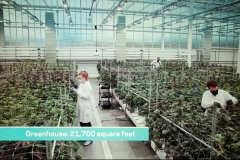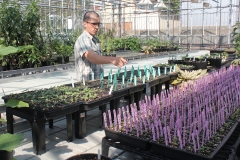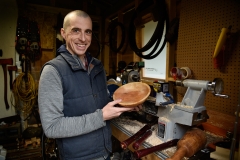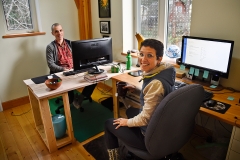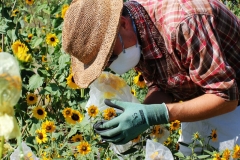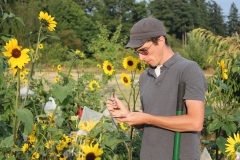The Town of Comox’s self-imposed period of reconsideration about the future of Mack Laing Park has created division not unity, and a growing rift on the issue among town councillors.

The Mack Laing Trust: BC Supreme Court hears arguments in 40-year case
Hamilton Mack Laing tends trees in his Nut Farm above Comox Bay in the early to mid 1900s
The Mack Laing Trust: BC Supreme Court hears arguments in 40-year case
The 40-year saga of an internationally famous naturalist and Comox Valley pioneer who left his waterfront property, possessions and money to the Town of Comox finally made it to the BC Supreme Court recently, where lawyers argued the legal technicalities of his Trust Agreement and his Last Will and Testament.
The the three-day proceedings in Courtroom 200 at the Courtenay Courthouse with Justice Jennifer A. Power presiding provided a stark contrast to the rich history and universal respect for the man, Hamilton Mack Laing, and his passion for the natural world and the biodiversity he found in the early 1920s along Comox Bay.
Instead, a lawyer for the Town of Comox and another for the BC Attorney General speculated on a broader meaning of certain words used in the Trust Agreement and other documents. They cited statues in municipal governance and jurisprudence that didn’t exist in 1973 when Mack Laing started making his gifts to the town or even in 1981 when he wrote his last wishes before he died in early 1982.
The lawyers hoped to convince Justice Power that despite misappropriating Laing’s money and misleading past council members, the Town of Comox should be allowed to demolish the man’s heritage home, Shakesides, and use his money for purposes that Laing had not explicitly envisioned.
They also spent a large portion of their time before Justice Power arguing that she should ignore most of the hundreds of pages of evidence and documentation submitted by the Mack Laing Heritage Society (The Society), an intervenor in this case, because they are “not relevant” to section 184 of the 2003 BC Community Charter.
They dismissed the numerous affidavits provided by The Society as “opinion and hearsay” that purport to describe Laing’s importance to the town’s history and the field of natural history generally and to prove that the terms of his gifts were crystal clear.
But something was missing in this cold, binary courtroom summarization of the legal fine points, which the lawyers so aptly boiled down to what was documented or not and which words were precise or vague and whether agreements made between 1973 and 1981 do or do not comport with a 2003 law. Absent from the discussion, except when The Society’s lawyer took the podium, was the context of the social-political-bureaucratic environment during which this 40-year travesty took place.
The Society’s lawyer did his best to paint that bigger picture. The Society believes that Justice Power, and anyone else masochistic enough to read through the mountain of public filings in this case, will discover the struggles of a lone female advocate for Laing’s wishes, the pursuit of personal agendas, the political strategies that were afoot and the unsavory means used to achieve them.
The Society believes Justice Power will learn that Laing was a good-hearted man, albeit naive about fickle town councils, who wanted his life’s achievements to live on and educate those who came after him and that the intention for his gifts to the people of Comox were clear and indisputable.
The Society’s lawyer said the Town of Comox had made its own mess and was now in a rush to clean it up. But, he argued, there is no good reason why, after 40 years, the town can’t wait for a thorough accounting of how much money should be in the Trust Fund and for an independent assessment of Shakesides’ viability by heritage building professionals.
After hearing from the town, the Attorney General and The Society, Justice Power gave no immediate ruling. Her decisions in this case could take weeks.
The Mack Laing saga is ultimately a story of how clever people can obfuscate the big picture using the detachment of legal proceedings and try to rewrite history to serve a modern agenda. It’s a cautionary tale about how municipal staff can lead a town council down an ethically wrong path and how a majority of them willingly follow it.
The case puts an exclamation point on the importance of electing mayors and council members who believe in playing by the rules. In other words, serious public servants who are determined to fully understand the issues before them and who refuse to take the lazy route of blindly accepting staff recommendations.
But that’s just our opinion.
What follows now is a brief summary of the arguments heard by Justice Power.
WHAT THE TOWN AND ATTORNEY GENERAL SAID
The BC Attorney General, represented by Sointula Kirkpatrick, and the Town represented by Mike Moll, argued that Laing had made two separate trusts. In the first one in 1973, the Park Trust, Laing gifted his property including the Shakesides house. In the second in 1981 via his Last Will and Testament, the Trust, Laing left the residue of his estate – money and possessions – to the town.
The lawyers said only the 1981 trust was before the court. That argument, if accepted by Justice Power, means that the Shakesides house was given to the town without conditions in the earlier Parks Trust and was the town’s property to do with as it pleased. The only issue before the court was whether the later Trust funds could be spent to construct a viewing platform.
“It has been 40 years since he made his bequest. Shakesides was never suitable to be a museum and the Trust Funds were and are not sufficient to make it one,” Kirkpatrick told the court.
She said further that “most of The Society’s evidence is not relevant to this court’s determination under Section 184 of the Community Charter.” And she went on to argue details of general trust law principles.
At that point, Justice Power stopped the proceedings to address the gallery, comprising only members of The Society. Justice Power said that despite the AG lawyer’s opinion of The Society’s evidence, only she would determine its relevance.
In regards to the comprehensive plan prepared by The Society and two dozen community volunteers to restore Shakesides and convert it to a natural history museum, Kirkpatrick said their proposal was “beyond the scope of this proceeding and has no basis in law.”
She concluded that the town’s proposal to construct a “Nature Park Platform can accommodate the K‘omoks First Nations’ concern about disturbance to the Great Comox Midden on which Shakesides is located, without further delay or unnecessary litigation.”
She said Mack Laing’s charitable intentions should be carried out through the building of the platform and she asked the court to “grant the variation sought on the conditions proposed by the Attorney General and to which the Town agrees.”
The town’s lawyer, Mike Moll said, “The Town is applying to vary the Trust because the Town’s Council now considers the terms of the Trust to no longer be in the best interests of the Town. The Town says that the Nature Park Platform containing natural history education panels will better further both the intention of the will-maker and the best interests of the Town.’
WHAT THE SOCIETY SAID
The Mack Laing Heritage Society, represented by Kevin Simonett of Campbell River, argued that “In breaching its obligations as trustee and allowing waste and neglect of the culturally valuable and irreplaceable trust object (Shakesides), Comox has manufactured the very crisis it now claims as justification to vary the trust.
“Comox does not come before the court with clean hands and is the author of a delay of several decades.”
Simonett went to say that after 40 years of the town’s financial mismanagement and dereliction of trustee obligations and fiduciary duty – “to which Comox has essentially admitted” – a forensic accounting of the trust funds and an independent assessment is required to ascertain the true financial health and structural integrity of Shakesides.
“Comox offers no explanation as to why they cannot wait for such forensic auditing
and physical inspection to be completed. Instead, they insist on immediate
demolition of a culturally valuable and historic home to be replaced with little more than a concrete slab,” he told the court.
Simonett argued that the town’s conclusion that Shakesides is unsuitable for use as a museum was “a foregone conclusion.” Since the town received Laing’s gifts, “the town has selectively sought out informal information tending to confirm that conclusion, rather than carrying out proper due diligence and obtaining expert opinions.”
He detailed how a town executive ignored the misspending of Laing’s money, stacked an advisory committee to get the result he wanted and then misled council members to make decisions based on a non-existent Park Plan and a flawed process designed to achieve personal and political purposes.
He argued that there was only one trust, not two, which Laing continued to amend through the period from 1973 to 1981.
“By way of gift in his last will and testament, the (Laing) carried out the Settlement upon the Park Trust; his intent was to add the residue of his estate to the trust corpus established under the Park Trust, on the terms set out in the instrument of gift. The Town in its capacity as Trustee had notice of these terms, and indeed had a hand in negotiating them, and accepted these terms when it accepted the funds forming the Settlement upon the Park Trust,” Simonett said.
Simonett told Justice Power that the town and the AG have provided evidence, “only on the putative cost-effectiveness of varying the Park Trust to remove Shakesides, and none as to the superiority per se of the viewing platform. It is the Intervenor’s position that the relative cost-effectiveness of the competing visions for Mack Laing Park has not been determined, due to the protracted intransigence of the town.”
SUBSCRIBE TO OUR NEWSLETTER
Town creates confusion, rift over Mack Laing process
MLHS issues letter of thanks to Comox Council
Mack Laing Heritage Society archive photo By George Le Masurier he Mack Laing Heritage Society this morning issued an open letter to the Town of Comox mayor and council. Here is their letter: We, the Mack Laing...
Comox must apologize for breaches of Mack Laing Trust
Comox Mayor Russ Arnott casts lone vote against out of court conversations to settle dispute over the Mack Laing Trust. But the town must apologize for its historic wrongdoing.
Comox Mayor no longer interested in Mack Laing talks
Business plan to restore Mack Laing’s heritage home unveiled, but mayor’s backtracking on a hand-shake agreement to negotiate out-of-court likely means more legal bills for Comox taxpayers
New Comox Council will protect Shakesides from leaky roof
The Mack Laing Heritage Society has waited 20 months for Comox to respond to their request to protect Shakesides from a leaky roof and causing further water damage. The new Town Council answered at its very first meeting
Court will allow opposing evidence in Mack Laing case
A BC Supreme Court has granted the Mack Laing Heritage Society intervenor status in the Town of Comox’s application to alter the naturalist’s public trust. MLHS hopes the new council is open to out-of-court discussions
Town’s Mack Laing “hub” aims to influence court
The timing of the Tow of Como’x new information hub about Mack Laing seems to indicate that it will function mostly to justify the town’s controversial decision to have the terms of the Mack Laing Trust altered by the B.C. Supreme Court and to report on the outcome of the case.
Questions the Town of Comox doesn’t want asked in court
Why is the Town of Comox fighting so hard and spending so much money on lawyers to keep the Mack Laing Heritage Society from presenting evidence during a BC Supreme Court trial to decide whether the town can vary the terms of the famous ornithologist’s financial gifts in trust to municipality?
Supreme Court rules in favor of Mack Laing Heritage Society
The Mack Laing Heritage Society has won a major legal ruling in its battle to force the Town of Comox to honor trust agreements with the famous naturalist. It’s the first step in a case that will decide the future of Laing’s iconic home and clarify the status of his trust agreements.
Shakesides supporters encouraged, hearing adjourned
A B.C. Supreme Court hearing scheduled for this morning (March 15) to determine whether to grant standing to the Mack Laing Heritage Society (MLHS) in the Town of Comox’s application to vary one of the famous ornithologis’s trusts has been adjourned until April. But Shakesides supporters left the court session encouraged.





